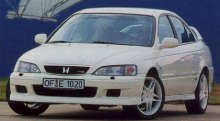Accord
Type R
 This
is the first time Honda launched a Type R in overseas before in local.
Having the experience of Integra Type R and Civic Type R, Honda
repeated
its know-how in creating the sporting Accord. Firstly, gives it a long
stroke, high torque 2.2-litre dohc VTEC engine which output an
impressive
209hp. (This engine has been appeared in the Japanese market Prelude
S-pec
/ Type-S) The high specific output is achieved by forged pistons,
polished
cylinder head, free-flow exhaust and by raising the compression ratio
from
10.6 : 1 to 11.0 : 1, and of course the VTEC. Unlike Integra's 1.8 unit
and Civic's 1.6 unit, the extra torque of the 2.2 unit enables
sufficient
pull since 2,000 rpm, making it unusually tractable. Power climbs
progressively
to 5,500 rpm, where the high speed cams cut-in, and then the engine
goes
wild until the sky-high 7,500 rpm redline. What an exciting machine
! This
is the first time Honda launched a Type R in overseas before in local.
Having the experience of Integra Type R and Civic Type R, Honda
repeated
its know-how in creating the sporting Accord. Firstly, gives it a long
stroke, high torque 2.2-litre dohc VTEC engine which output an
impressive
209hp. (This engine has been appeared in the Japanese market Prelude
S-pec
/ Type-S) The high specific output is achieved by forged pistons,
polished
cylinder head, free-flow exhaust and by raising the compression ratio
from
10.6 : 1 to 11.0 : 1, and of course the VTEC. Unlike Integra's 1.8 unit
and Civic's 1.6 unit, the extra torque of the 2.2 unit enables
sufficient
pull since 2,000 rpm, making it unusually tractable. Power climbs
progressively
to 5,500 rpm, where the high speed cams cut-in, and then the engine
goes
wild until the sky-high 7,500 rpm redline. What an exciting machine
!
Yet the
4-cylinder is smooth,
frugal and not noisy, even after the sound-deadening material was
removed
to save weight. (The Type R is some 57kg lighter than the normal
2.0-litre
Accord, well done !)
Then, the chassis
is stiffened
up some 40%, thanks to the tower bar reinforcing the rear bulkhead.
Accompany
with the necessary stiffening in springs and dampers, lower ride
height,
17in 215/45 tyres, front Limited Slip Differential and the 2.9-turn
lock
to lock steering, no wonder Autocar's tester highly praised the
handling
of the Type R.
Thanks to the
rigid body
and new steering mechanism, the steering has a lot more feedback than
the
Integra Type R, which was only criticised in this area. Besides, it
turns
smoothly, consistently and responsively. This is in the league of BMW.
Remember, the Honda is front-wheel-drive.
Apart from the
crisp handling,
it also rides extremely good. Actually it is not much harsher than the
standard Accord and smoother than Mondeo V6 as well as the Vectra GSi.
300mm diameter disc brakes stop the car effectively.
Enter the cabin,
you won't
complain the dark carbon fiber trimming and the supportive Recaro, nor
the titanium-coloured shifter knob. It is as cool as keen drivers want.
Otherwise remains the same as the standard Accord - faultless built and
trustible reliability.
This doesn't mean
the Accord
Type R has no shorts (which car is perfect ?) Firstly, the widely
spaced
gear ratio does not suits the wide rev range of the VTEC engine. It
should
have employed a six-speeder. Secondly, also lastly, it is quite
expensive.
In UK it cost 23,250 pounds at launched, way above Vectra GSi's 20,520
and even Alfa 156 V6's 22257. There's no free lunch !
|